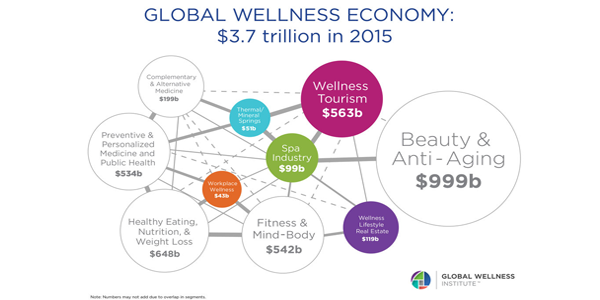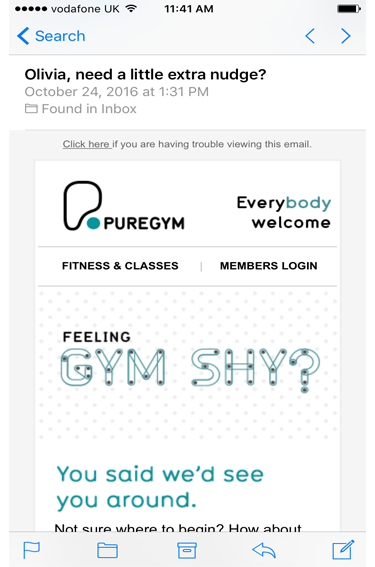Health, Wellness and Fitness Digital Trends and Stats for 2017
2016 saw consumers strive for self-improvement more than ever before. Fitness, health and wellbeing products were some of the most prevalent ways that this consumer trend came to light.

The wellness economy was estimated at $3.7 trillion in 2015 (11% year on year growth)1, encompassing fitness, public health, healthy eating, wellness tourism, beauty and anti-aging. But how are these industries changing and what kind of digital marketing opportunities are developing.
Digital trends in fitness
The fitness market has felt the added uncertainty of Brexit and a generally tumultuous economic climate that has prevailed in 2016. This doesn’t mean that the fitness market has declined, but rather, that an opportunity has arisen in the low-cost market. Consumers are cancelling expensive gym memberships in favour of working out independently or budget alternatives.
The private low cost sector now accounts for:
- 12% of the total number of private clubs2
- 13% of the private market value2
- 32% of the private sector membership2
The low cost market utilises online channels to connect with customers. The leading low cost fitness operator Pure Gym understands the modern consumer’s busy lifestyle and limited budget. Using a variety of marketing channels that reach the consumer across devices to suit their needs at the time. By taking many customer interactions online, Pure Gym gathers client data where other luxury gyms don’t.
At online sign up Pure Gym asks you to set your goals for attendance and fitness. When the customer is entering the gym which is open 24/7 (to allow for consumes busy lifestyle) this attendance data is used in their CRM system which triggers emails to the customer, either reminding them of their attendance targets (set on sign up) or congratulating them.

Taking the inter-personal element out of the interaction with your customer can actually be what they are craving. Thinking about the psychology behind the typical gym goer, trying to fit one more thing into their already jam packed schedule by keeping fit and attending a gym – taking out the face-to-face interaction can be seen as a bonus.
Digital marketing tips for the fitness industry in 2017
- Gather data from your customers on their goals and desires for the gym
- Keep a well maintained CRM system with as much data as possible
- Engage with your customers on their terms
The growth of low cost gyms has contributed to 1 in every 7 people in the UK being a member of a gym, an all-time penetration rate high of 14.3%2.
Digital trends in wellbeing and health
Other research by Accenture estimates that the global health and wellbeing market will grow to $737 billion by 20183. This growth will largely be driven by categories like vitamins nutrition, weight management and fortified foods as the consumer trends continue towards self-improvement and health.
The self-improvement industry continues to benefit from the digital revolution. From the popularisation of hardware like the FitBit through to apps designed to help improve health and fitness health and tech are going hand in hand. In fact, it is estimated that by 2017, 1.7 billion will have at least one m-health app installed3.
As consumers become more savvy about health with the help of m-apps and instant internet knowledge, interest in healthy eating and supplements naturally grows in line with consumer health concerns. One study of 5,000 consumers found that 1 in 2 could now distinguish between a “good” and “bad” carb4. Super foods high in vitamins and antioxidants are also peaking public interest with searches for the spice du jour “turmeric” increasing 300% in from 2011 to 2016.
Wellbeing and health digital marketing tips in 2017
Brands should consider incorporating the following into their digital marketing strategies to complement their health and wellness SEO and PPC campaigns.
- Optimise your website to be found in search engines for superfoods or health foods
- Consider how technology, can take advantage of the data you have on your customers to create new products and solutions for them
- Anticipate innovation in trending superfoods and provide content for a savvy audience around the benefits and uses of superfoods
Conclusion
As niche tastes in exotic superfoods and supplements drives consumers online to meet their needs, fitness apps and technology are increasingly able to gather and crunch data that helps consumers achieve their personal goals. Even the most physical of services - gyms are taking their marketing online to reach the consumer on their terms and grow engagement between gym and customer.
Thanks for reading
If you enjoyed reading this post on health, fitness and wellbeing trends, check out my other posts on industry, digital marketing and consumer trends. Or why not sign up to our guest list and get all the best blogs from ThoughtShift delivered to your email.
Sources
- https://www.globalwellnessinstitute.org/press-room/statistics-and-facts/
- http://www.leisuredb.com/blog/2016/5/11/press-release-2016-state-of-the-uk-fitness-industry-report
- https://www.accenture.com/gb-en/insight-consumer-healthcare-market-high-performance-business-research-2013
- http://www.telegraph.co.uk/wellbeing/health-advice/seven-wellness-trends-to-watch-in-2016/
